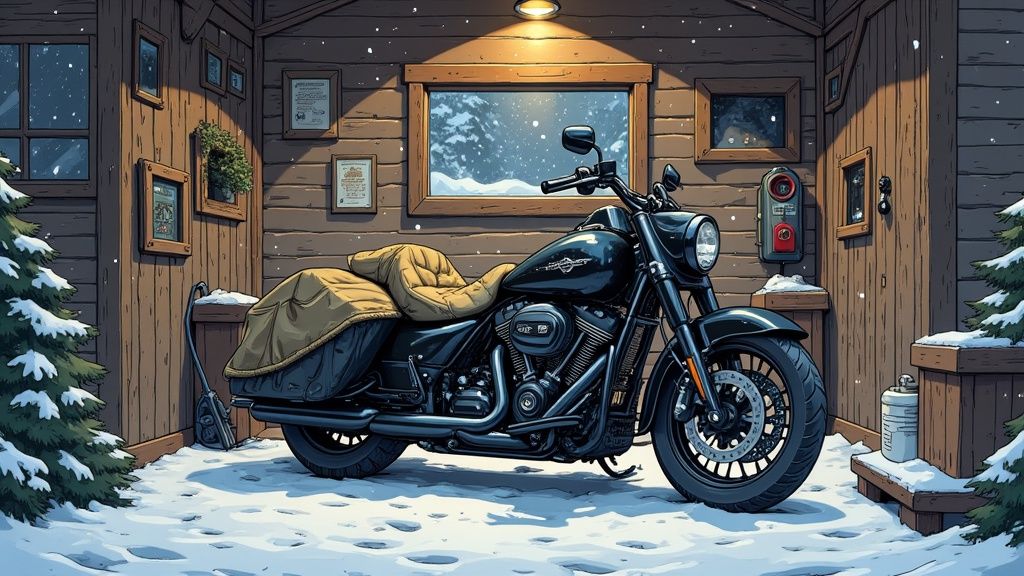
How to Winterize Your Motorcycle: A Complete Guide for Protecting Your Ride
Understanding Why Proper Winterization Matters
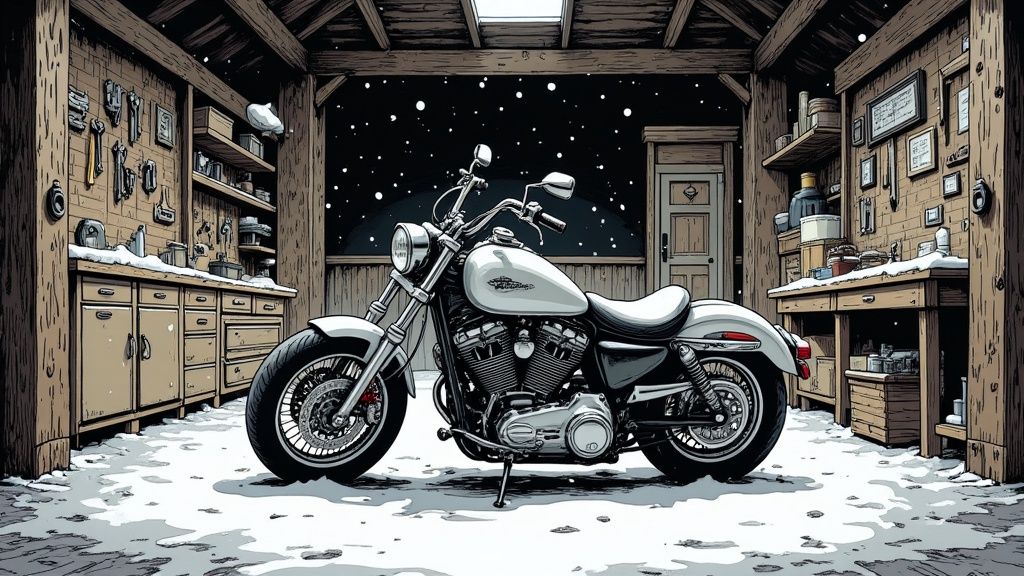
Taking the time to properly winterize your motorcycle is essential for keeping it in great condition during the cold months. Just like we bundle up to stay warm, bikes need special care to handle winter’s challenges. The most vulnerable parts are the engine internals and electrical systems - frozen fluids can crack engine components, while batteries often drain when motorcycles sit unused for extended periods.
Common Winter-Related Damages
Cold weather storage often leads to serious moisture problems in motorcycles. Without proper preparation, rust and corrosion can develop quickly, potentially leading to repair bills in the thousands. The fuel system is particularly at risk - condensation building up in gas tanks and lines can result in hard starts and poor performance when spring arrives.
Preventive Steps Against Theft
Beyond protecting your bike from weather damage, security should be a top priority during winter storage. Many riders don’t realize that motorcycle thefts remain common in winter months. In fact, the National Insurance Crime Bureau reports that the four slowest months still account for 25% of annual motorcycle thefts. Make sure to keep your bike in a secure location to prevent theft. Learn more about winterization best practices.
Areas of Overlook
It’s easy to miss some of the key details when winterizing your motorcycle. For example, maintaining proper tire pressure prevents flat spots from developing. The battery needs special attention too - either remove it completely or connect it to a trickle charger. Remember to change fluids, add fuel stabilizer, and lubricate all moving parts to maintain the bike’s mechanical health.
A thorough understanding of winterization helps you develop an effective protection plan. When done right, proper winter storage ensures your motorcycle will be ready to hit the road as soon as warmer weather returns.
Selecting and Optimizing Your Winter Storage Location
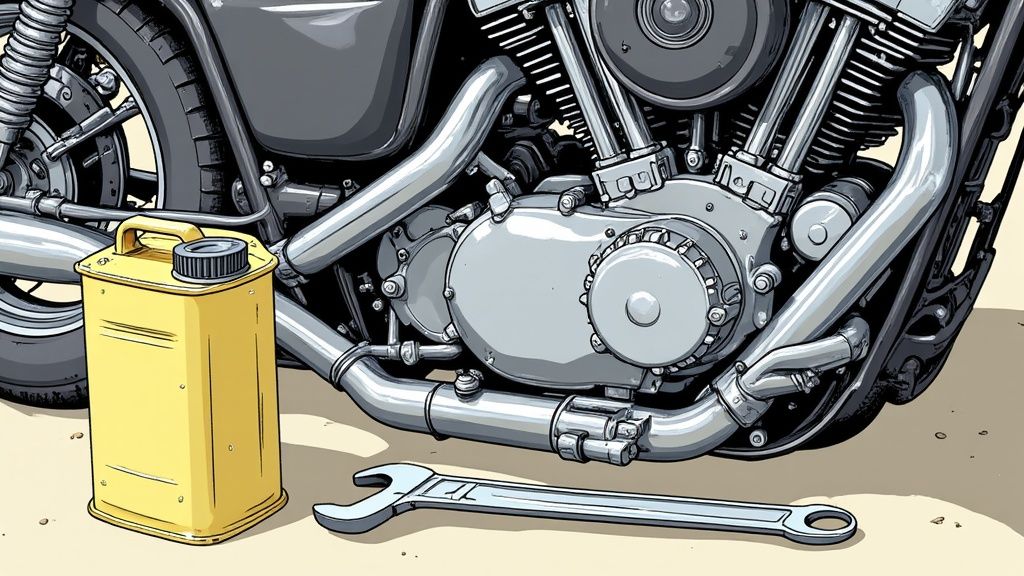
Proper motorcycle storage over winter requires careful consideration of where and how you store your bike. The right storage environment helps prevent damage and costly repairs when spring arrives. Let’s explore your storage options and how to create optimal conditions for your motorcycle’s winter hibernation.
Evaluating Storage Options
A heated garage provides the best protection for your motorcycle by maintaining stable temperatures and low moisture levels. This controlled environment helps prevent rust and keeps rubber components from deteriorating. However, not everyone has access to heated storage.
An unheated garage or storage shed can work well with some extra precautions. While temperature changes are less than ideal, these spaces still shield your bike from direct weather exposure. When using unheated storage, focus on proper ventilation to prevent moisture buildup. A breathable cover can help, but be cautious as covers can sometimes trap dampness.
If you must store your bike outdoors, invest in a high-quality motorcycle cover specifically designed for winter weather. Make sure to secure the cover tightly to prevent wind damage. For guidance on proper winter storage techniques, check out this comprehensive storage guide.
Optimizing Your Chosen Space
Creating the right storage environment requires managing three key factors: temperature, humidity, and airflow. Think of this as creating a comfortable home for your bike during its winter rest.
- Temperature: Aim for steady temperatures to protect sensitive components. Extreme cold can damage batteries and electronics, while heat may degrade fluids and rubber parts.
- Humidity: Excess moisture leads to rust and corrosion. Use a dehumidifier in enclosed spaces and check humidity levels regularly.
- Ventilation: Good air circulation prevents moisture and stagnant air problems. Ensure some airflow, especially if using a cover.
Security Measures
Protecting your motorcycle from theft is just as important as protecting it from weather damage. A good storage plan includes both physical security and preventive steps.
- Physical Security: Install quality locks, chains, and alarm systems. Add motion-sensor lights or security cameras for extra protection.
- Preventive Steps: Keep your bike out of sight when possible. Update your insurance to include theft coverage during storage. Document your motorcycle’s condition with photos for insurance purposes and maintenance records.
By carefully considering these storage factors and taking appropriate protective steps, you can create an effective winter storage solution for your motorcycle. Keep detailed records of your storage setup and maintenance activities - this documentation helps track what works best and provides proof of proper care if needed later.
Mastering Critical Fluid Management and Protection
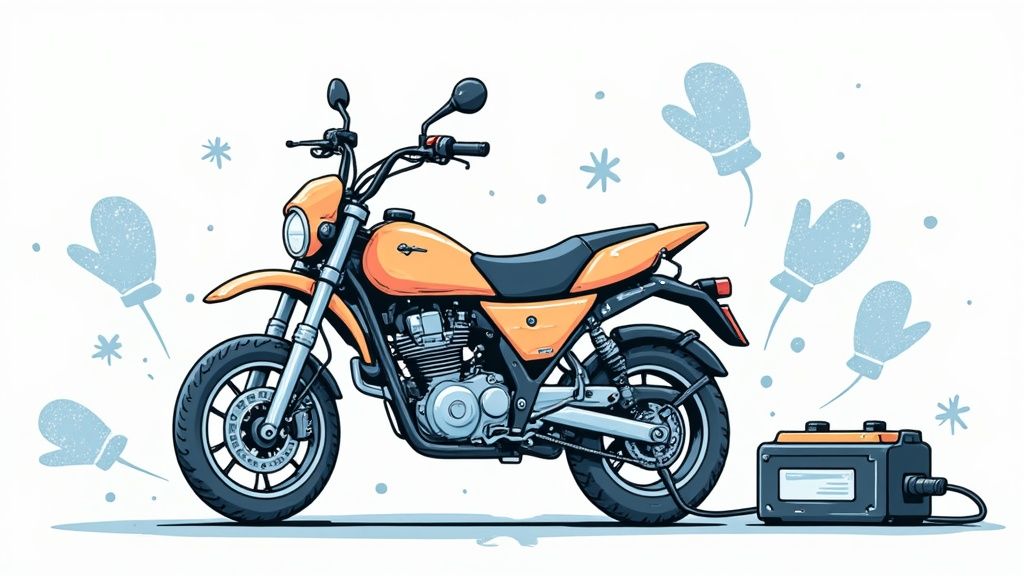
Taking care of your motorcycle’s fluids is essential for winter storage. This involves more than just changing the oil - it requires checking and maintaining all the vital fluids that keep your bike running smoothly.
Oil Changes and Beyond
Start by giving your bike a fresh oil change and new oil filter. During long storage periods, old oil can damage engine components. Getting this right means your bike will start up more easily when spring arrives. Don’t forget to check other key fluids too - your brake fluid and coolant levels need attention since temperature changes can affect them significantly.
Timing and Climate Conditions
The timing of your fluid changes matters, especially in harsh winter areas. Do your maintenance just before storage to prevent fluids from sitting stagnant too long. If you live somewhere with severe winters, you may need stronger anti-freeze protection than riders in milder climates.
Fuel System Protection
Many riders overlook their fuel system when winterizing. Gasoline starts breaking down after just 21 days, leading to deposits and potential damage. Add a fuel stabilizer as directed, top off the tank with fresh gas, and run the engine briefly to protect the entire fuel system. This simple step helps both newer and classic motorcycles. Discover more insights about fuel stabilization here.
Professional Techniques for High-Value Motorcycles
Professional motorcycle shops use detailed methods to prepare expensive bikes for winter storage. Their approach includes thorough fluid inspections and premium protective products. You can adapt these professional techniques to keep your bike’s fluid systems in top condition throughout the winter months.
Good fluid management does more than protect your motorcycle during storage - it makes getting back on the road much smoother when winter ends. Follow these steps carefully, and you’ll find your bike ready to ride when warm weather returns.
Protecting Your Electrical System for Long-Term Storage
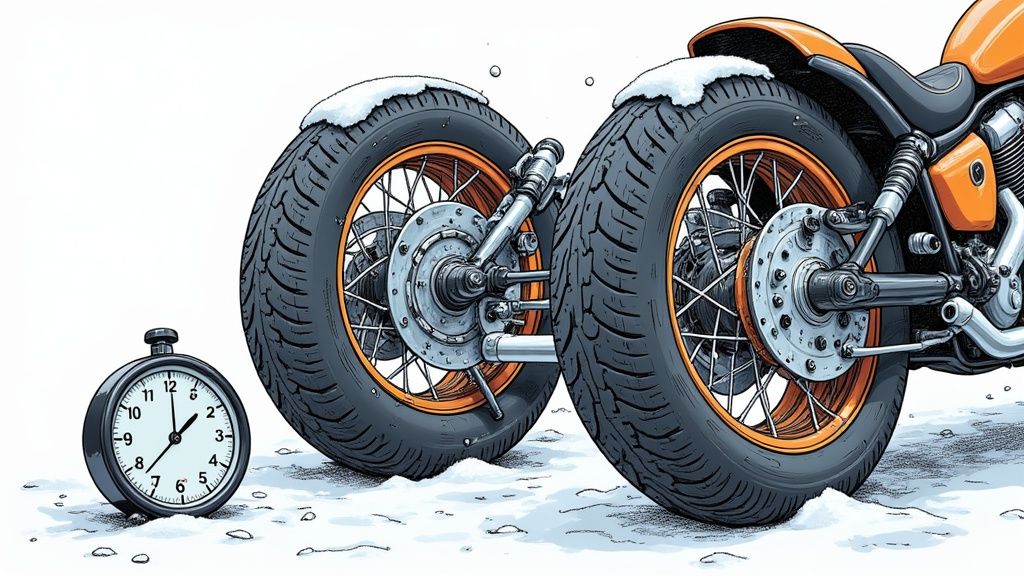
As winter approaches, taking proper care of your motorcycle’s electrical system becomes crucial for avoiding problems when spring returns. Just like preparing your home for winter, your bike needs specific attention to keep its electrical components in good shape during storage.
Battery Maintenance Essentials
The battery is particularly vulnerable during winter storage. Without regular use, batteries naturally lose their charge over time. To prevent this, remove the battery and keep it in a cool, dry location away from extreme temperatures. Using a battery maintainer or trickle charger helps preserve the battery’s health throughout storage - just be careful not to overcharge, as this can reduce battery life.
Disconnecting and Protecting Electronics
To avoid electrical issues during storage, disconnect any non-essential electrical components. For motorcycles stored outside or in areas prone to frost, apply a corrosion inhibitor spray to electrical terminals. This simple step helps prevent rust and ensures solid connections when you’re ready to ride again in spring.
Regular Health Checks
Before storing your bike, test all electrical components to catch any issues early. A multimeter can help verify proper voltage levels - if you’re not comfortable doing this yourself, have a professional mechanic inspect the system. Finding and fixing small problems now prevents them from becoming major repairs later.
Real Cases and Preventive Measures
Experience shows that damaged wiring from moisture is one of the most common winter storage problems. For example, many riders have saved thousands in repair costs by applying dielectric grease to connections. This creates an effective moisture barrier that keeps water away from sensitive wiring.
Taking these steps to protect your motorcycle’s electrical system helps ensure everything works properly when warmer weather returns. By being proactive about maintenance now, you can look forward to trouble-free riding in spring. For help tracking all your motorcycle maintenance tasks, check out Auto Service Logger.
Preserving Your Motorcycle’s Exterior and Finishes
When getting your motorcycle ready for winter storage, protecting its exterior is just as crucial as mechanical preparation. The key is taking a systematic approach to shield every surface from winter’s effects. By using the right techniques and products for each material type, you can keep your bike looking showroom-fresh until spring arrives.
Advanced Cleaning Techniques
Start with a deep clean using proper methods for each surface. Painted areas need gentle care - use a mild soap with a microfiber cloth to avoid scratches. Follow up with a wax-based polish to create a moisture barrier, which is essential for preventing water damage and corrosion on painted and metal surfaces. This thorough preparation sets the foundation for long-term protection.
Protective Products for Different Materials
Each part of your motorcycle needs specific care based on its material:
- Metals: Coat chrome and anodized parts with a specialized aerosol lubricant that forms a thin protective film
- Plastics: Use a silicone-based spray to prevent cold weather damage and keep plastic components from becoming brittle
- Leather: Apply a quality leather conditioner to maintain flexibility and stop cracking in seats and other leather pieces
Think of this as preventive maintenance - each component needs its own protective treatment to stay in top condition through winter storage.
Surface Protection Strategy
Your storage environment plays a big role in preservation. For outdoor storage, invest in a quality breathable cover that blocks moisture while allowing airflow. If storing indoors, pick a dry space away from dust and pests that could harm finishes. Consider adding a small dehumidifier to control moisture levels and prevent corrosion.
Product Recommendations
Here are tested products that work well for different materials:
| Material | Product Type | Recommendation |
|---|---|---|
| Metals | Aerosol lubricant | WD-40 Specialist Long-Term Corrosion Inhibitor |
| Paint | Wax-based polish | Meguiar’s Ultimate Liquid Wax |
| Plastics | Silicone protectant | 303 Aerospace Protectant |
| Leather | Leather conditioner | Lexol Leather Conditioner |
Using these proven techniques and quality products helps ensure your motorcycle stays in excellent condition during winter storage. Keep detailed maintenance records using Auto Service Logger to track all your preservation efforts and maintain your bike’s condition year-round.
Preparing for Spring: Your Return-to-Riding Strategy
After winter storage, getting your motorcycle back on the road takes careful preparation to maintain both safety and optimal performance. Like an athlete returning to training after the off-season, your bike needs thoughtful attention before hitting the pavement again.
Inspection Techniques for Safe Revitalization
Start with a complete inspection of key components, especially those most affected by long-term storage. Check the condition of brake pads and fluids for safety. Carefully examine tires for signs of cracking or flat spots that often develop during extended periods without use. Make sure to inspect and lubricate the chain, cables, and controls to ensure they operate smoothly.
System Reactivation Procedures
Bringing your motorcycle’s systems back online requires a methodical approach. Begin with the electrical components - check that the battery holds a proper charge and remains in good condition. Test all lights, signals, and gauges after reconnecting any disconnected parts. Next, start the engine to get fluids moving through the system. Pay close attention to any strange noises that could point to mechanical problems needing repair.
Professional Troubleshooting Methods
When issues arise, use a step-by-step diagnostic process similar to professional mechanics. For example, if you notice irregular idling or stalling, examine the fuel system for blockages that commonly occur during storage. Don’t hesitate to seek expert guidance or professional service for problems beyond your expertise. Finding and fixing small issues early prevents bigger headaches later.
Testing and Verifying System Functionality
Set aside dedicated time to thoroughly test every component. Create a checklist covering essential systems like brakes, clutch, transmission, and electronics to ensure nothing gets overlooked. This focused approach helps verify everything works correctly while building confidence in your bike’s readiness for the road ahead.
Following these steps helps your motorcycle transition smoothly from winter storage to spring riding. Consider using Auto Service Logger to document all maintenance work, making it simple to track service history and stay on top of upkeep tasks.